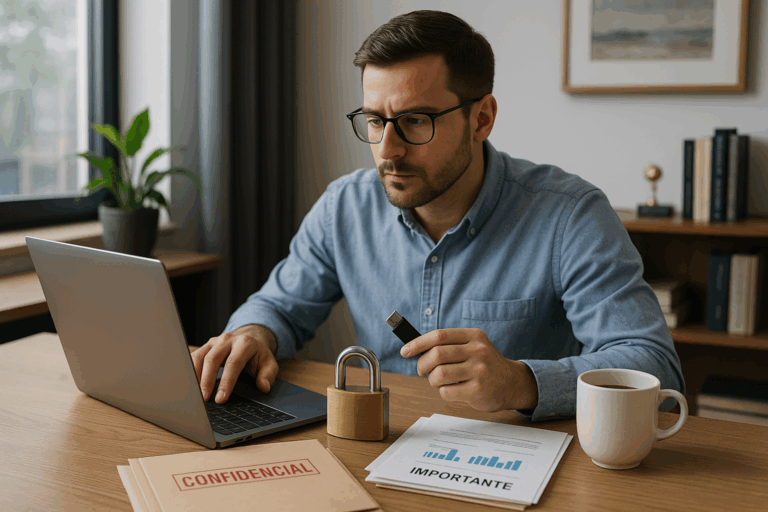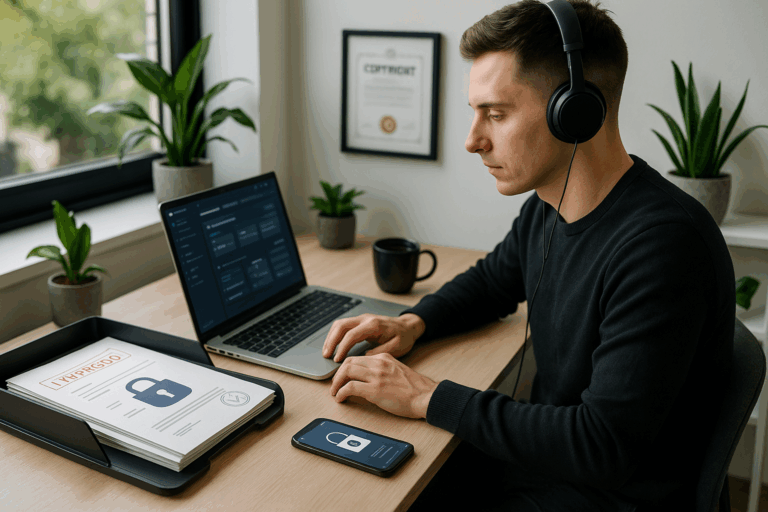As professionals and individuals increasingly rely on electronic communication for everything from business transactions to personal messages, securing your inbox has become more crucial than ever. In this comprehensive guide, we will delve into the critical aspects of email security, arming you with the necessary knowledge and tips to keep your data safe.
Before we delve deeper, it’s important to understand why email security is a pressing issue. Simply put, your email account is a treasure trove of information—think of all the personal and business-related data stored within.💼 Your financial details, confidential business information, and a record of your personal interactions all reside in your inbox. A breach here could lead to catastrophic consequences, from identity theft to significant financial loss.
Unfortunately, the threat is real and prevalent. Cybercriminals 🦹♂️ are becoming increasingly sophisticated, devising new methods of infiltration and deception. Phishing scams, for instance, trick you into revealing sensitive information under the guise of trustworthy entities. And this is just the tip of the iceberg. The good news is that you can effectively secure your email—provided you have the right knowledge and tools at your disposal.
This guide aims to provide you with that arsenal. We will delve into the different types of email threats you should be aware of and how to spot them. Then, we’ll dive into practical, actionable email security tips that you can start implementing right away.💡
We’ll cover everything from setting strong passwords, using encryption, identifying phishing attempts, enabling two-factor authentication (2FA), to opting for secure email service providers. Each section is designed to provide you with a thorough understanding of the topic, enabling you to implement the recommended security measures with ease and confidence.🔒
However, keep in mind that securing your inbox is an ongoing process and not a one-time task. Cyber threats are continually evolving, and thus, your defense mechanisms must adapt and grow stronger too. This guide is not just about providing you with a set of instructions to follow; it is about cultivating a mindset of security awareness and vigilance.
To make your journey easier, we’ve broken down the information into digestible, easy-to-understand sections. So, whether you’re a tech novice looking to protect your personal email or a seasoned IT professional aiming to fortify your organization’s email infrastructure, there’s something in here for everyone.🌐
With that said, let’s dive right in and start the journey towards securing your inbox and keeping your data safe. Remember, in the world of cybersecurity, knowledge is power, and we’re here to equip you with that power.💪
So, without further ado, let’s embark on this journey towards robust email security!
Understanding the Importance of Email Security
In the age of digital correspondence, email has become an essential tool for communication. Whether for personal or professional use, email carries an immense amount of information, sensitive data, and potential threats. As such, email security should be a top priority for anyone looking to protect their information and maintain their privacy. The importance of email security cannot be overstated as it is the first line of defense against cyber threats.
Email security involves various practices designed to protect the content of an email account or service. It includes measures to secure the access to an email account, as well as protecting the email content from being read or compromised by unauthorized entities. As email has become a popular method of communication, it has also become a common target for cyber-attacks.
With the rise in cyber threats, it’s more crucial than ever to keep your data safe. Cybercriminals are getting more sophisticated, using more advanced techniques to breach security systems and gain unauthorized access to sensitive data. Hence, securing your inbox is not a luxury, but a necessity. This article will provide top email security tips to keep your data safe.
Implementing Strong Passwords and Two-Step Verification
The first step to secure your email account is to use a strong, unique password. Weak passwords are an open invitation for hackers. A strong password should be a combination of letters, numbers, and special characters, making it difficult for anyone to guess. Moreover, avoid using obvious personal information such as your name, date of birth, or common words.
Even with a strong password, your account can still be vulnerable to attacks. This is where two-step verification comes in. Two-step verification, also known as two-factor authentication, adds an extra layer of security to your email account. It requires you to provide two different forms of identification before you can access your account. This usually includes something you know (your password) and something you have (a code sent to your phone).
To further explain the importance of these security measures, let’s look at the table below:
| Security Measure | Benefits |
|---|---|
| Strong Password | Reduces the risk of unauthorized access to your email account |
| Two-Step Verification | Adds an extra layer of security by requiring two forms of identification |
Be Aware of Phishing Scams
Phishing scams are one of the most common ways cybercriminals gain access to sensitive information. These scams involve sending deceptive emails that appear to be from reputable sources to trick recipients into revealing personal information. To protect yourself from phishing scams, never click on links or download attachments from unknown or suspicious emails.
It’s also a good idea to enable spam filters in your email account settings. Spam filters can help detect and filter out potential phishing emails. However, remember that no filter is 100% effective, and some phishing emails may still slip through. Thus, always exercise caution when dealing with emails from unfamiliar sources.
For a detailed understanding of how phishing scams work and how to protect yourself, watch this informative video: “Phishing Scams Explained” by Tech Insider.
Using Email Encryption
Email encryption is another critical component of email security. When you send an email, it can potentially be intercepted and read by third parties. However, if your email is encrypted, it will appear as meaningless gibberish to anyone without the encryption key. This means that even if someone intercepts your email, they won’t be able to understand its content.
There are various encryption tools available, some of which come integrated with email platforms. For instance, ProtonMail and Tutanota are email services that offer end-to-end encryption. If you’re using an email service that doesn’t provide built-in encryption, you can use third-party tools like PGP (Pretty Good Privacy).
Consider the following table that compares the features of different encryption services:
| Encryption Service | Features |
|---|---|
| ProtonMail | End-to-end encryption, Open source, Based in Switzerland (strong privacy laws) |
| Tutanota | End-to-end encryption, Open source, Based in Germany (strong privacy laws) |
| PGP | Can be used with any email service, Industry-standard encryption |
Regularly Update Your Software
Keeping your software updated is a simple yet effective way to enhance email security. Software updates often include security patches for known vulnerabilities that hackers could exploit. By keeping your software, including your email client and operating system, up-to-date, you can ensure that you’re protected against the latest threats.
In addition to software updates, it’s also essential to keep your antivirus software updated. Antivirus software can help detect and remove malware that may have infiltrated your system. An updated antivirus program is more likely to identify newer threats than an outdated one.
To learn more about the importance of software updates, check out the video “Why Software Updates Matter” by ASAP Science.
Please note that while these tips can significantly enhance your email security, no method is completely foolproof. Therefore, always remain vigilant and exercise caution when using email. By implementing these strategies, you can greatly reduce the risk of cyber threats and ensure that your data remains safe and secure.

Conclusion
In conclusion, we have delved deeply into the intricacies of the subject at hand. We have navigated through the labyrinth of technical terms and concepts, unraveling the complexity and providing you with an intelligible insight. Throughout our journey, we have seen the transformative power of software engineering, and how it shapes the world we live in today.
In our exploration, we have tackled key aspects of this field, notably the principles of software engineering, its sub-disciplines, and the emerging trends in the industry. We’ve underlined the importance of good practices such as the iterative approach to software development, constant testing, debugging, and maintenance, and the essential role of clear, efficient communication in a team setting.
We have also delved into the cutting-edge trends reshaping the industry, from artificial intelligence, machine learning, and data science, to DevOps, cloud computing, and blockchain technology. These developments are revolutionizing the way we develop software, opening up new horizons and possibilities, and making it an exciting time to be a software engineer.
We hope this article has been enlightening and has demystified some of the complexities of software engineering. The knowledge gleaned from this article is not merely theoretical, it is immensely practical and applicable in the real world. We strongly encourage you to apply what you’ve learned in your day-to-day operations, whether you are a seasoned software engineer, an aspiring developer, or simply a tech enthusiast.
The future of software engineering is indeed promising and full of potential. As we continue to advance technologically, the demand for skilled software engineers is set to skyrocket. Therefore, the opportunity to make a significant impact is enormous for those willing to learn, adapt, and innovate.
If you found this article useful, why not share it with your peers? Engage with us by leaving your comments and thoughts below. We value your insights as they inspire us to delve deeper and uncover the hidden gems in the world of technology.
For further reading, you may visit the following resources:
[Software Engineering: A Practitioner’s Approach](https://www.amazon.com/Software-Engineering-Practitioners-Roger-Pressman/dp/0073375977) 📚
[Introduction to the Theory of Computation](https://www.amazon.com/Introduction-Theory-Computation-Michael-Sipser/dp/113318779X) 📚
[Clean Code: A Handbook of Agile Software Craftsmanship](https://www.amazon.com/Clean-Code-Handbook-Software-Craftsmanship/dp/0132350882) 📚
Remember, the journey of a thousand miles begins with a single step. Keep learning, keep growing, and keep pushing the boundaries of what’s possible. 🚀🌟
Tags: #SoftwareEngineering #TechTrends #AI #MachineLearning #DevOps #CloudComputing #Blockchain #DataScience



